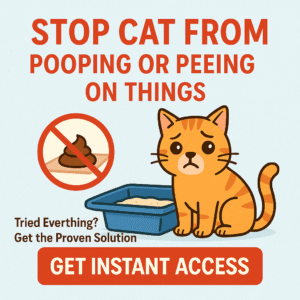Worried about that painful lump on your cat’s skin? You’re not alone—and while vet care is essential for serious cases, gentle at-home measures can support healing. In this guide, you’ll learn how to care for minor abscesses, spot danger signs, and reduce risks. Plus, discover how the Cat Spray No More ebook gives ongoing care routines and hygiene strategies to help your cat stay healthy long-term.
Introduction
Cat abscesses are painful pus-filled lumps—usually the result of bite wounds or scratches. They’re common in outdoor and multi-cat homes. While deep or large abscesses must be treated by a vet, smaller ones often respond to warm compresses, clean care, and monitoring. This article teaches you safe, effective at-home steps, red flags for veterinary care, and how Cat Spray No More supports both cleanup and prevention.
What’s a Cat Abscess?
An abscess is an enclosed pocket of infection formed beneath the skin. It typically develops after bacteria invade through a bite or scratch, triggering inflammation and pus buildup. You’ll notice a tender, swollen, warm lump, sometimes weeping pus. If unaddressed, it can burst unexpectedly or spread deeper—so timely action is crucial.
When You Can Treat at Home vs. When to See a Vet
Safe to treat at home:
- Lump under 1 cm (less than half an inch)
- No fever; cat remains active, eating normally
- No sudden discharge, foul odor, or worsening swelling
Seek vet care immediately if you see:
- Abscess larger than a golf ball or deep-seated
- Fever, lethargy, loss of appetite
- Rapid swelling, red streaks, foul-smelling pus
- Your cat seems in severe pain or refuses treats
Step-by-Step Care Routine at Home
1. Keep It Clean: Wash Your Hands First
Before you start, thoroughly wash your hands. Wear disposable gloves if possible—this stops bacteria from spreading.
2. Warm Compresses: The Healing Secret
- Soak a clean cloth or gauze in warm water (not hot).
- Wring gently and place it on the lump for 5–10 minutes.
- Repeat 3–4 times daily to soften and encourage drainage.
Why it works: Warm compresses increase blood flow to the area, helping the abscess either drain naturally or become soft enough to express at the vet.
3. Gentle Draining (If Softened)
Only attempt this if the abscess has softened significantly and small pus appears without pressure.
- Clean the skin around the abscess with warm saline (1 tsp salt per cup of water).
- Gently apply pressure from the edges—not the center—with a clean gauze pad.
- Stop at the first sign of bleeding—do not force pus out.
- Wipe away any fluid, then apply a fresh saline-soaked compress.
IMPORTANT: Never lance or puncture the abscess yourself—internal structures could be harmed and infection worsened.
4. Apply Topical Healing Ointment
After draining, apply a thin layer of an antibiotic ointment (e.g., Neosporin, vet-approved). Avoid any ointment containing pain relief medication unless prescribed by your vet.
5. Bandage Carefully if Needed
If the abscess is dripping or in a thick-furred area, loosely bandage with non-stick gauze and light wrap. Change it daily during compresses and ointment application.
6. Monitor & Support Healing
Keep a healing journal with the Cat Spray No More tracking sheets—monitor these daily:
- Abscess size and texture
- Presence or absence of redness, swelling, heat
- Pus color (yellowish or clear is OK; green, gray, or bloody is not)
- Behavior changes—energy, appetite, mood
If symptoms worsen or drainage persists for over 5–7 days, schedule a vet visit.
Additional Care Tips For Faster Recovery
- Prevent licking and scratching: Use an e-collar or soft cone to stop irritation.
- Maintain a clean environment: Disinfect bedding, eliminate clutter—that’s hygiene support emphasized in Cat Spray No More.
- Boost nutrition: Feed high-quality protein and omega-3 fats to support skin repair. Frozen thawed chicken breast works well.
- Manage stress: Provide quiet space and comfort—stress slows healing. The ebook includes stress-reduction routines perfect for recovery periods.
- Consider probiotics: Gut health supports immune recovery. Ask your vet for a cat probiotic supplement.
Signs You Must See the Vet Fast
- Size increasing or spreading beyond half an inch depth
- Pus turning greenish, gray, or smelly
- Fever (feel warmth around abscess, check if cat is lethargic)
- Red streaks tracking under skin toward the body
- Failure to eat or move for more than 24 hours
These are strong indicators of systemic infection requiring antibiotics, drainage, or surgical cleaning by a professional.
How Cat Spray No More Helps Today—and Tomorrow
This ebook isn’t just about odors—it empowers you with routine strategies for health emergencies like abscesses. Here’s how it supports your care routine:
- Daily care checklists: Warm compresses, bandage changes, symptom logs
- Stress & healing environment tips: Set up recovery zones in your home
- Nutrition boost plans: Easy recipes for protein-rich meals and skin support
- Preventive insights: Avoid scenarios like fights and scratches that lead to abscesses
Want full caregiver confidence? Download Cat Spray No More and take control of your cat’s wellbeing—whether it’s odor, skin problems, or abscesses.
Real Cat Owner Success Story
“When my tomcat came home limping with a swollen lump, I was scared. With the ebook’s care schedule, compress routine, and healing meals, we saw dramatic improvement in a week. Vet confirmed no further issues!”
Conclusion
A small cat abscess doesn’t have to lead to surgery or stress—but only if you act carefully. Keep it clean, use warm compresses, drain gently when needed, apply ointment, monitor progress, and protect against licking. Once vets rule out deeper infection, these steps often lead to full recovery.
Need organized care, recovery tracking, and prevention strategies? Cat Spray No More gives you the plan—from daily care to peace of mind—so your cat can heal faster and you can feel confident every step of the way.
